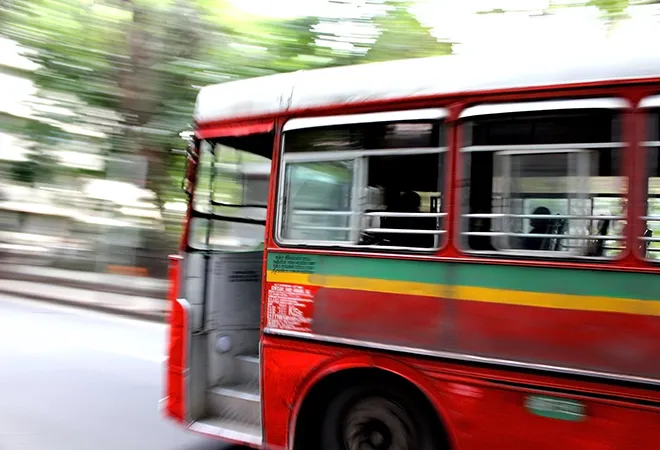-
CENTRES
Progammes & Centres
Location
The foremost mode of transport in cities of developing economies, bus services, are also the most economical.

Four Indian cities — Bengaluru, Mumbai, Pune and Delhi — feature in this years’ Tom Tom index of congested cities in the world, with Bengaluru wearing the thorny crown of being the most congested city globally. Various factors contribute to congestion on roads in Indian cities. However, the much talked about “panacea” to city traffic i.e. metro rail systems, exist in three among the above four cities. This just goes to show that merely having a metro network doesn’t necessarily get cities out of logjam. What is urgently required, in addition to metro, are more systemic changes to be put in place. Last-mile connectivity is one of the major reasons for this congestion and should be tackled at the earliest.
Reforming the city bus system is one of these changes that can solve the issue of last-mile connectivity and reduce congestion. The foremost mode of transport in cities of developing economies, bus services, are also the most economical. Bus service improvements have been found to be immediately effective. A bus network can be easily reconfigured to meet changing demands and patterns of commute in a city. Cities all over the world are looking at reforming their bus sector through the renewal of their core activities like network planning and reconfiguration, procuring, operating and monitoring bus services. However, Indian cities seem to be so focused on the metro systems that, city bus services are being sidelined — often at the cost of introducing inefficiencies in the entire transit network.
The Brihanmumbai Electricity Supply and Transport Undertaking (BEST) is an undertaking of the Municipal Corporation of Greater Mumbai (MCGM) which operates Mumbai’s city buses. In recent years, BEST has faced a lot of flak from transit analysts and commuters alike for ailing finances and an ageing fleet. Imprudent operational decisions like running AC buses on several routes which went kaput. Additionally, financial instability of BEST had led to the closure of many existing routes. Since 2003, due to the discontinuation of cross-subsidy from the power distribution wing of the agency, the finances of the bus transport wing were gravely affected. Most of the bus networks in Indian cities suffer with bad finances due to failure in raising fares, rise in employee salaries and increasing fuel, lubricant and spares costs. There are various efforts underway for the revival of BEST. Recently, they undertook a fare cut which led to a phenomenal rise in ridership but a sharp decrease in revenues.
The undertaking, however, seems to have found the method to arrest the mounting losses, by focusing on feeder services and last-mile connectivity. The need for bus services on long distance routes has been largely addressed by the metro services that run either under or over the city’s main and arterial roads. Therefore, city bus services have to now suitably alter their approach to meet the newer needs that metro lines have created. The BEST recently launched point-to-point mini AC bus services at various locations in the city. Till date about 200 buses are active on about 25 routes and more are being launched soon. These services are a part of an effort to revive the bus services, in line with changing needs of the commuter and changing commute patterns in sync with the existing and upcoming metro network.
The 21-seater mini buses operate for short distances on point-to-point or minimal halt routes. This eliminates the time taken to drag the bus on narrow city roads, stopping at every junction and increasing the time lag faced by passengers on already congested streets and crowded buses. Currently, these buses are run on a wet-lease basis, which means the BEST hires buses from private contractors, who provide both buses and drivers. This lets the BEST launch this initiative without the initial capital investments in fleet and human resources. Eventually, BEST plans to own 50% of the total mini- bus fleet.
The point-to-point nature of travel eliminates the need for additional manpower (bus conductors) in every bus, reducing the strain on BEST revenues for manpower deployment. The tickets, are usually distributed to commuters at origin points or at the terminating stops. Tickets rates have been slashed from the previous INR 25 to INR 6 (per five kilometres), in a bid to make comfortable travel affordable for the common man. The service has been introduced at several bus depots/terminals in the city, connecting major places of work and residence with the nearby train and metro stations. BEST plans to make 400 mini buses operational by early 2020. A month after its launch in November 2019, these mini buses started earning INR 20,000 daily. At the same time, this move led to busting of the taxi and auto-rickshaw syndicate who charged commuters with exorbitant prices and led to congestion and pollution near transit hubs.
This experiment has shown success in terms of solving last-mile connectivity issues. In the long run, the BEST plans to get 6,000 such buses and intends to eventually increase them to 10,000. Currently, the buses run on diesel. However, the transport agency must eventually shift to a more sustainable power source. Also, at present, there is not much done in the way of commuter engagement except Twitter notifications for the newly launched bus routes. The mini buses will have to be integrated with the BEST bus app, to ensure ease of use for commuters.
This point-to-point, last-mile bus service has provided a useful blueprint for better planning of transport networks in a city, especially bus services. BEST and bus authorities in various cities of India need to redefine their roles and responsibilities to posit themselves as a complementary service to other modes like metros and trains. To optimise the bus transport networks, transit providers need to take into consideration the following points.
With the evils of congestion and pollution damaging most cities in India, city transport systems have to reform themselves keeping in tune with the latest developments in passenger preferences. City transport services are largely operating in silos and will have to work in tandem with each other to provide seamless, affordable, point to point mobility with minimum mode changes where bus systems can play an important role.
For this, the various public transport service providers in a city — bus, train, metro, monorail, etc. need to jointly workout aspects like route planning, service provision, intermodal alignments, transit area planning, fare structures, fare distribution for a common mobility card, real-time transit updates through a single point of communication through IoT. However, the situation is grim in most Indian cities since the Unified Metropolitan Transport Authority (UMTA), bereft of any statutory powers, has failed to achieve its goals. There are a lot of turf wars between different transport agencies, both city-wide and state-wide, hampering the functioning of UMTA.
Introduction of metro networks, easy access to cab aggregators and other forms of shared mobility options like taxi and auto-rickshaws have posed an existential crisis to city bus systems. The onus now lies on bus service providers to get all the other stakeholders — including commuters — on board through sustained outreach and transform themselves as a vital city essential.
A strong political champion is necessary to defend the changes that such a systemic reform will bring about. Financial backing through a dedicated institutional support system is needed to sustain the reform. Fleet upgradation and capacity building of planners, operators and executives is crucial to achieve successful and sustainable reforms. Countries across the world like Turkey, Philippines, France, etc. have instituted bus service reforms in their cities. It’s time for Indian cities to follow suit.
The views expressed above belong to the author(s). ORF research and analyses now available on Telegram! Click here to access our curated content — blogs, longforms and interviews.

Ameya Pimpalkhare is an Associate Fellow at ORFs Mumbai Centre. He works on the themes of energy and transportation. His key research interests include: sustainable ...
Read More +